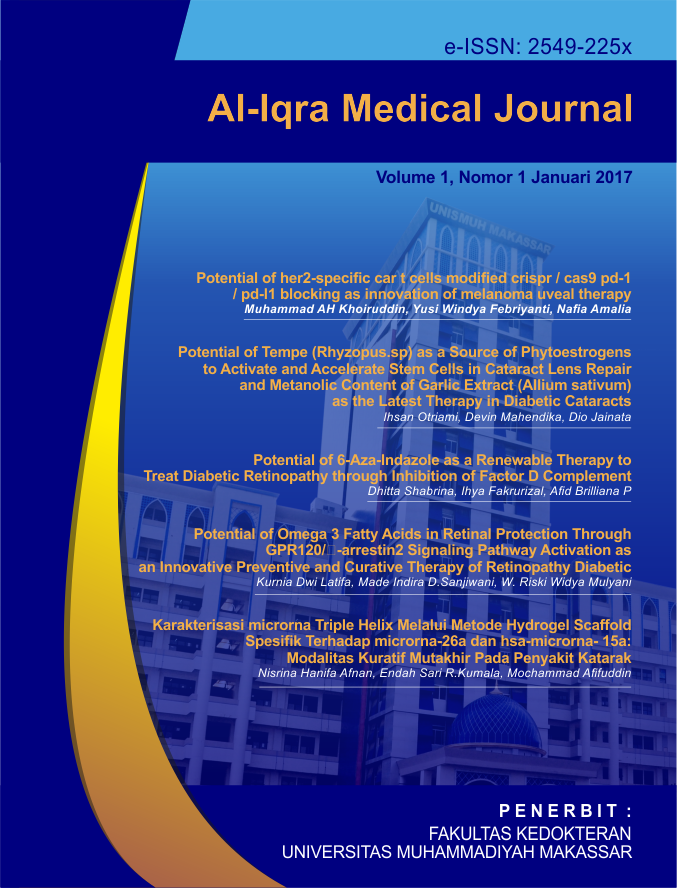GLYCOLYTIC 2-DEOXY-D-GLUCOSE PERIOCULAR INHIBITOR SEBAGAI TERAPI ADJUVANT PADA RETINOBLASTOMA
DOI:
https://doi.org/10.26618/aimj.v1i2.2750Abstract
Retinoblastoma is the most common intraocular tumor in children. Retinoblastoma tumors consist of areas with high angiogenic activity and other areas with low oxygen pressure conditions. Tumor cells that survive in this hypoxic region have been shown to be resistant to chemotherapy and radiation, namely standard retinoblastoma therapy which selectively targets rapidly dividing cell populations, so that therapy is needed that can reach up to the hypoxic cells. 2-deoxy-D-glucose (2-DG) has been shown to be effective in reducing hypoxic areas in tumors, reducing tumor buds, and inhibiting angiogenesis. to discuss the glycolytic 2-DG inhibitors as adjuvant therapy in retinoblastoma. The authors searched for medical articles in the PubMed and ResearchGate literature databases with the keywords treatment, 2-deoxy-D-glucose, 2-DG, retinoblastoma, and cancer. The words are combined with OR or AND using Boolean logic. Based on the selection according to the inclusion and exclusion criteria, 4 articles were used as the main reference for writing this review literature.
2-DG will disregulate (inhibit) the process of angiogenesis through upregulation of Estrogen Receptor 1 Nuclear (ESR 1), ubiquitin, jun activation domain binding protein 1 (JAB1), G-protein alpha S, and CAPER in the apical part of the tumor and B3GNT1 upregulation , CEPT1, PABPC1, myotrophin, HAX1 in the postero-lateral part of the tumor. H3, DTX1, RPL12, and bone morphogenic (BMP) histones are also upregulated so that hypoxia can be inhibited. With this mechanism, the tumor burden can be suppressed. Glycolytic 2-DG inhibitors with anti-angiogenesis and anti-hypoxic abilities can be developed as adjuvant therapy for advanced retinoblastoma patients.
References
Union for International Cancer Control. Retinoblastoma Review of Cancer Medicines on the WHO List of Essential Medicines [Internet]. WHO. 2014 [cited 19 May 2019]. Available from: https://www.who.int/selection_medicines/committees/expert/20/applications/Retinoblastoma.pdf?ua=1
de Camargo B, de Oliveira Ferreira J, de Souza Reis R, Ferman S, de Oliveira Santos M, Pombo-de-Oliveira M. Socioeconomic status and the incidence of non-central nervous system childhood embryonic tumours in Brazil. BMC Cancer. 2011;11:160.
Pina Y, Decatur C, Murray TG, et al. Retinoblastoma treatment: utilization of the glycolytic inhibitor, 2-deoxy-2-fluoro-D-glucose (2-FG), to target the chemoresistant hypoxic regions in LHBETATAG retinal tumors. Invest Ophthalmol Vis Sci. 2012;53:996-1002.
Rares L. Retinoblastoma. Jurnal e-Clinic. 2016;4(2):1-8.
Liu Y, Dean DC. Tumor initiation via loss of cell contact inhibition versus ras mutation: do all roads lead to EMT? Cell Cycle. 2010;9:897–900.
Pina Y, Houston SK, Murray TG, et al. Retinoblastoma treatment: impact of the glycolytic inhibitor 2-deoxy-D-glucose on molecular genomics expression in LHBETATAG retinal tumors. Clinical Ophthalmology. 2012;6:817–830.
Pina Y, Houston SK, Murray TG, et al. Focal, periocular delivery of 2-deoxy-D-glucose as adjuvant to chemotherapy for treatment of advanced retinoblastoma. Invest Ophthalmol Vis Sci. 2010;51:6149-6156.
Houston SK, Pina Y, Murray TG, et al. Novel retinoblastoma treatment avoids chemotherapy: the effect of optimally timed combination therapy with angiogenic and glycolytic inhibitors on LHBETATAG retinoblastoma tumors. Clinical Ophthalmology. 2011;5:129–137.
Merchan JR, Kova´cs K, Railsback JW, Kurtoglu M, Jing Y, et al. Antiangiogenic Activity of 2-Deoxy-D-Glucose. PLoS ONE. 2010;5(10):e13699.
Kollodge T, Hinkley S. Retinoblastoma; a scientific and clinical review. Vision Dev & Rehab. 2015;1(1):39-45.
Augsburger J, Bornfeld N, Giblin N. Retinoblastoma. Yanoff M and Duker J. Ophthalmology. Edinburgh: Mosby Elsevier; 2009. p. 887-93.
Ganguly A, Nichols K, Grant G, Rappaport E, Shields C. Molecular karyotype of sporadic unilateral retinoblastoma tumors. Retina. 2009;29(7):1002-1012.
Jorde L, Carey J, Bamshad M. Medical genetics. Philadelphia: Mosby Elsevier; 2010.
Shields CL, Mashayekhi A, Au AK, et al. The international classification of retinoblastoma predicts chemoreduction success. Ophthalmology. 2006;113(12):2276–2280.
Schefler AC, Cicciarelli N, Feuer W, Toledano S, Murray TG. Macular retinoblastoma: evaluation of tumor control, local complications, and visual outcomes for eyes treated with chemotherapy and repetitive foveal laser ablation. Ophthalmology. 2007;114(1):162–169.
Rouic LL, Aerts I, Levy-Gabriel C, et al. Conservative treatments of intraocular retinoblastoma. Ophthalmology. 2009;115:1405–1410.
Ziemssen F, Wegner R, Wegner J, et al. Analysis of neovasculature in uveal melanoma by targeting the TGFbeta-binding receptor endoglin: is there prognostic relevance of proliferating endothelium? Graefes Arch Clin Exp Ophthalmol. 2006;244:1124–1131.
Chan HS, Gallie BL, Munier FL, Beck Popovic M. Chemotherapy for retinoblastoma. Ophthalmol Clin N Am. 2009;18:55–63.
Pedersen PL, Mathupala S, Rempel A, Geschwind JF, Ko YH. Mitochondrial bound type II hexokinase: a key player in the growth and survival of many cancers and an ideal prospect for therapeutic intervention. Biochim Biophys Acta. 2010;1555:14–20.
Jockovich ME, Bajenaru ML, Pina Y, et al. Retinoblastoma tumor vessel maturation impacts efficacy of vessel targeting in the LHBETATAG mouse model. Invest Ophthalmol Vis Sci. 2009;48:2476–2482.
Folberg R, Hendrix MJ, Maniotis AJ. Vasculogenic mimicry and tumor angiogenesis. Am J Pathol. 2011;156:361–381.
Dewhirst MW, Cao Y, Moeller B. Cycling hypoxia and free radicals regulate angiogenesis and radiotherapy response. Nat Rev Cancer. 2008;8(6):425–437.

